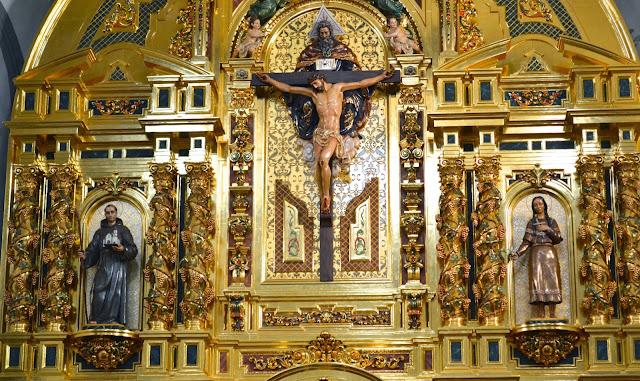This isn't a bad thing, it's a testament to the conservators' determination to keep it looking authentic, even when they had to rebuild something. One part that has not been rebuild is the "Great Stone Church", or what remains of it. These ruins bear a resemblance to the ruins of Rome. So of course I loved them!
This beauty was build between 1797 and 1806, the only chapel in the region not made from adobe. While all that work was going on, they held services in Sierra's Church, which had been build way back in 1782. The Stone Church was big and beautiful and must have been a wonder to behold but it was not around for very long. In 1812 an earthquake took the bell tower straight down on the congregation, killing over 40 of them. The rest of the church survived the earthquake so they gave a shot at rebuilding it, but that didn't amount to much. The Stone Church had used four cast bells, each one named after a saint. The priests dug out the bells (or presumably had their converts do the digging), built a nice wall next to the church to display them,
and went back to holding services in Serra's Church. When Mexico took over these lands, just as they did at the Mission San Luis Rey, they ousted the priests and their neophytes. And just like the priests at that Mission, these Franciscans stopped on their way out to take the pictures off the walls. Eventually President Lincoln gave this Mission back to the Catholic Church, just as he did with the Mission San Luis Rey. Not much happened here until 1910 when Father John O'Sullivan arrived and got interested in rebuilding. By then only parts of the Great Stone Church that remained were fragments of the walls and the back of the sanctuary. But aren't they gorgeous!
That same year Hollywood got involved, filming "Two Brothers" here, and in 1916 the caretakers started charging a 10 cent admission to help pay for the restoration. There must have been a lot of dimes because it's come a long, long way.
The four mission bells continued to hang outside, even though the two larger ones had cracked in the earthquake. It wasn't until 2000 that they recast those two, so now all 4 bells can ring. The 2 cracked bells hang in a separate display.
The forty-plus victims of the earthquake are buried in a modest cemetery behind the Stone Church, along with at least 1,960 others. All unmarked, and frankly I don't know where they put them all - it's not a very big area. This is more of a mystery than the 10,000 bodies in Savannah's Colonial Park Cemetery. There is a big monument near Father O'Sullivan's grave, but it's a memorial to the builders of the Mission.
Behind the Stone Church is a group of buildings with a central patio (very scenic, of course). Among other things, these include a museum, workshops and soldiers' barracks. We walked through the compound, enjoying one photogenic view after another: the back of the bell wall,
corridors of arches,
and doorways topped with what looks to me like stylized sea biscuits.
The walls of all these buildings are very thick, as every door and window shows, which made excellent sense in the hot California weather.
One damaged ceiling shows the original sycamore beams and strips of reeds used in the 1780s construction. Adobe was plastered over this to add insulation.
And off to one side is a garden, planted with fruits and vegetables similar to what the original inhabitants grew, such as cabbage, tomatoes, lettuce and onions. Right next to the garden are the remains of several outdoor kitchen pits and ovens. Here women cooked 2 meals a day for up to 1,000 people. Not fun!
The walls are decorated with 14 stations of the cross. Just like the ones in the Mission San Luis Rey, the Franciscans returned the original paintings when the Mission belonged to them again. The paintings are small and dark, except for station number 10. Number 10 is unusual. It's 12 feet tall.
Sometime in the 1970s restoration was considered but discarded in in favor of creating another painting to cover it. Go figure. Forty years later someone realized there were two paintings in the frame and removed the top one to reveal this one, well over 200 years old. But the new one must have been pretty good, to go unnoticed so long.In the front of the church is a beautiful gold-covered alter. Quite amazing.
We needed to beat the traffic on 5 South, so we left by 1:30. But before we left, we took a quick look at the nearby Mission Basilica. It's a a large church, beautifully decorated, but without the ostentatiousness that I usually find in Catholic Basilicas. A nice touch are the "portraits" of Saints painted on the whitewashed walls.
Another unusual feature is that there is no organ loft over the door. But up at the front, the alter is decked out in gold. And one of the characters depicted near the top of it is an Indian woman. I found out later that she is Kateri Tekakwitha, the daughter of a Mohawk chief on the East coast. After her death she was made a saint and even though she never traveled to California, she was added to this retablo as a symbolic gesture of unity with the many Indian converts.
And the swallows who come here yearly? Apparently that hasn't happened the last few years. Too many changes in the area, resulting in other places to nest. I think it would be great if they came back, but this Mission is outstanding on it's own.


















No comments:
Post a Comment